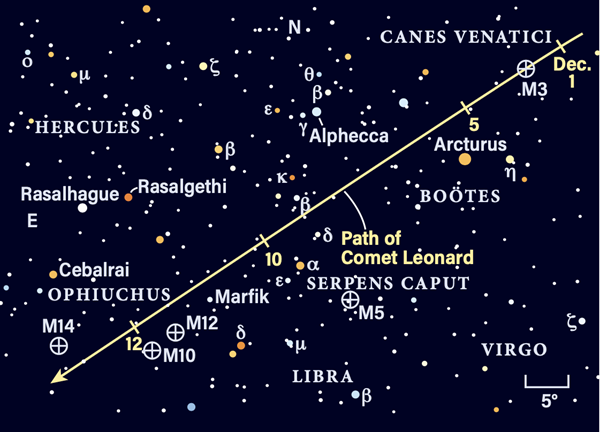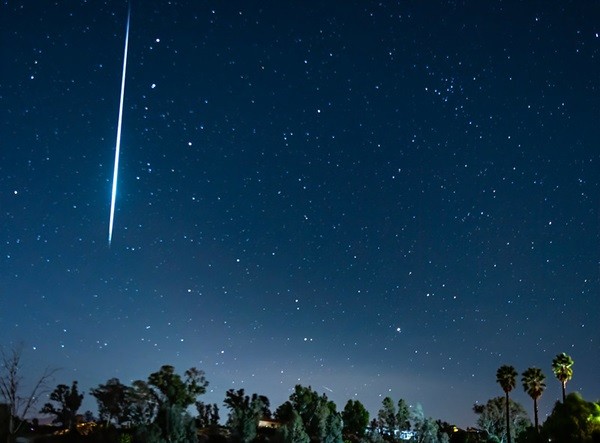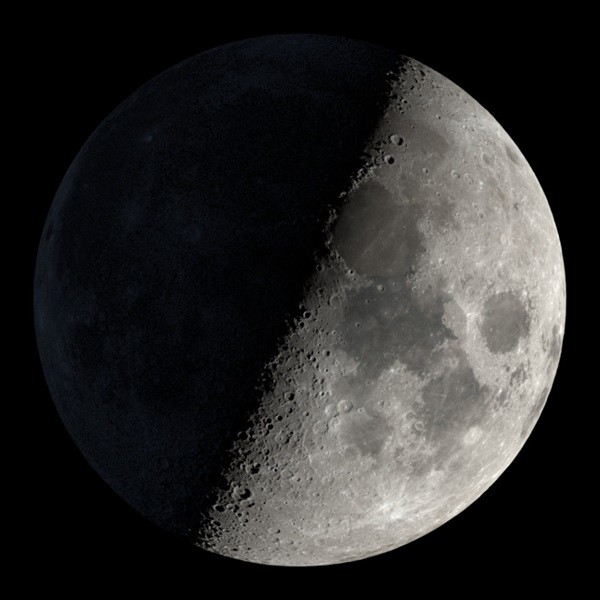
Total solar eclipse: This stunning image of the July 11, 2010, total solar eclipse was taken from Easter Island. December 4’s total solar eclipse will touch only the continent of Antarctica.
Friday, December 3
With no Moon in the sky tonight, it’s time to enjoy a classic target at its best: the Orion Nebula (M42). Hanging below Orion’s Belt about 3.7° south-southwest of magnitude 1.7 Alnitak, M42 covers a broad swatch of sky spanning 85' by 60'. Its 4th-magnitude glow is easily visible to the naked eye under good conditions, but turn binoculars or a telescope on this magnificent star-forming factory and you’re in for a real treat.
Because it is so large and bright, M42 offers a wealth of detail so conspicuous that several features have well-known nicknames. The Fish’s Mouth refers to the dark dust lane at M42’s northern edge, which separates it from the smaller M43. The bright region at the nebula’s western side is called the Sail, while the Sword sits on its eastern edge. At the heart of the nebula is the Trapezium Cluster: Small telescopes can resolve four suns in this tight-knit group of bright, massive stars. Larger apertures will bring two more into view for a total of six stars.
Sunrise: 7:05 A.M.
Sunset: 4:35 P.M.
Moonrise: 6:13 A.M.
Moonset: 4:06 P.M.
Moon Phase: Waning crescent (1%)
*Times for sunrise, sunset, moonrise, and moonset are given in local time from 40° N 90° W. The Moon’s illumination is given at 12 P.M. local time from the same location.
Saturday, December 4
New Moon occurs at 2:43 A.M. EST, right in the middle of a total solar eclipse that first begins when the Moon’s penumbra touches Earth at 12:29 A.M. EST and ends when it leaves at 4:37 A.M. EST. The total phase, which begins at 2:00 A.M. EST, lasts just 1 minute 54 seconds. The added catch is that this eclipse is only visible over land in Antarctica. For those on voyages to see this spectacle from one of the last frontiers on Earth, good luck!
Shortly after the eclipse ends this morning, the Moon also reaches perigee, the closest point to Earth in its orbit around our planet. At 5:04 A.M. EST, it will sit 221,702 miles (356,795 kilometers) away.
For those who aren’t able to travel, there’s still a magnificent sight to see today: Venus reaches greatest brilliancy at 9 A.M. EST, blazing at magnitude –4.9. Although you can’t see it then, you’ll easily find it in the southern sky at sunset, still 20° high and slowly setting over the next three hours or so. It’s joined to the southwest by bright Saturn and Jupiter, forming a straight line along the ecliptic. Saturn’s magnitude 0.6 glow lies 16.7° east of Venus, while Jupiter, shining at magnitude –2.3, is 16.6° east of Saturn. If you’re out around 9:35 P.M. EST with a telescope, you can catch Jupiter’s moon Io disappearing behind its large disk at that time. It won’t reappear — far to the planet’s east, once it slides out of Jupiter’s long, dark shadow — until after midnight, when the planet has set for most observers.
Sunrise: 7:06 A.M.
Sunset: 4:34 P.M.
Moonrise: 7:33 A.M.
Moonset: 4:56 P.M.
Moon Phase: New
Sunday, December 5

Comet C/2021 A1 (Leonard): Early this month, Comet Leonard swipes past globular cluster M3 — compare their appearance! After midmonth, you’ll want to switch from morning to evening viewing. Our friends south of the equator see only the second half of the performance.
It’s Comet C/2021 A1 (Leonard)’s time to shine! Rising by 2 A.M. local time, your best bet for catching this comet until next week is in the few hours before sunrise, as it climbs higher in the southeastern sky in the constellation Boötes. This tiny ball of ice and dust currently sits less than 6.5° north of the constellation’s brightest star, magnitude –0.1 Arcturus. It’s also floating tonight just 7° east-southeast of the 6th-magnitude globular cluster M3, which lies just over the celestial border in Canes Venatici.
In the right pair of binoculars, you should be able to just capture both the comet and the cluster in the same field of view. Compare their appearance: M3 is about 18' across, while 8th-magnitude Leonard should appear smaller, about 8' wide.
Make sure to keep an eye on this comet as it skims southeast each morning: By the end of this week, Leonard is estimated to reach naked-eye brightness before quickly fading again back to 8th magnitude by the end of the year.
Sunrise: 7:07 A.M.
Sunset: 4:34 P.M.
Moonrise: 8:48 A.M.
Moonset: 5:56 P.M.
Moon Phase: Waxing crescent (3%)
Monday, December 6
Now moving away from the Sun, the Moon’s first stop is Venus: Our satellite sits less than 3.5° below the bright planet this evening. Just over 2.5 days old, the Moon is a delicate waxing crescent perfect for showing off earthshine. This phenomenon occurs when sunlight reflects off Earth, partly illuminating the portion of the Moon’s face still in shadow.
The pair is located in Sagittarius, which lies in the direction of the Milky Way’s rich central bulge. There are plenty of deep-sky targets here, although the fading twilight and low altitude will make them a challenge. But nearby Aquarius hosts three Messier catalog entries to hunt down: globular clusters M2 and M72, as well as the strange object M73. Consisting of only four stars that astronomers don’t believe are physically related, this asterism lies about 1.5° east of M72.
Sunrise: 7:08 A.M.
Sunset: 4:34 P.M.
Moonrise: 9:54 A.M.
Moonset: 7:05 P.M.
Moon Phase: Waxing crescent (9%)
Tuesday, December 7
After sliding under Venus yesterday, today the Moon passes 4° south of Saturn at 9 P.M. EST. They’ll have already set by then, but you can easily catch the pair earlier at sunset, located in the constellation Capricornus.
The Moon is now a slightly larger waxing crescent, slowly growing brighter as the number of days since New Moon increases. Saturn is magnitude 0.6, sitting midway between much fainter, 5th-magnitude Eta (η) and Rho (ρ) Capricorni. Zoom in with a telescope to see the planet’s fantastic ring system, stretching 35" across — more than half the width of the planet’s disk, which is 16" in diameter. You may also spot the planet’s largest and brightest moon, magnitude 8 Titan, sitting nearly 1.5' northwest of Saturn tonight.
Now is the time to enjoy views of Saturn, as it will steadily sink lower each night. As objects get closer to the horizon, we’re looking at them through more of Earth’s atmosphere, which blurs the image and degrades its quality.
Sunrise: 7:09 A.M.
Sunset: 4:34 P.M.
Moonrise: 10:48 A.M.
Moonset: 8:18 P.M.
Moon Phase: Waxing crescent (17%)
Wednesday, December 8

Geminid meteor: A bright Geminid seems to fall to earth above Temecula, California.
Since officially beginning on the 4th, the Geminid meteor shower has been ramping up for its peak next week. Although there are a few days to go, now is still a great time to catch shower meteors. That’s because the Moon is currently a thin crescent with less than 30 percent of its face illuminated; it also sets before midnight and doesn’t rise until after the Sun.
The Geminids’ radiant is located near the bright star Castor in the Twins. Your best bet for seeking out shooting stars is in the early morning a few hours before sunrise, when the constellation is highest in the sky. Try to observe from a dark location with little to no ground light, as any light will wash out fainter meteors.
Geminid meteors typically move through the atmosphere at some 22 miles (35 km) per second, burning up completely so that nothing is left behind. The dust and debris that creates these meteors is associated with the strange near-Earth asteroid 3200 Phaethon.
Sunrise: 7:10 A.M.
Sunset: 4:34 P.M.
Moonrise: 11:30 A.M.
Moonset: 9:32 P.M.
Moon Phase: Waxing crescent (26%)
Thursday December 9
The Moon passes 4° south of the giant planet Jupiter at 1 A.M. EST. Both are below the horizon at that time, but you can see them this evening, now nearly 9.5° apart in two separate constellations. Jupiter lies in Capricornus, just 3.2° from the bright star Deneb Algedi. The waxing Moon is now in Aquarius, headed for a close meetup with the distant ice giant Neptune tomorrow.
Some 15° south-southeast of the Moon tonight is the 1st-magnitude star Fomalhaut. The alpha star in the constellation Piscis Austrinus the Southern Fish, this sun is famous for the large disk of planet-forming debris that surrounds it. Within this disk, astronomers spotted what they believed was a large exoplanet forming. Over the course of several years, they even watched this object move in its orbit around the star. But then, in 2014, the so-called planet disappeared.
It turns out, that planet wasn’t a planet at all! Instead, the object was likely the remnants of a past collision between two large icy bodies, the likes of which now litter our own solar system’s Kuiper Belt and Oort Cloud.
Sunrise: 7:10 A.M.
Sunset: 4:34 P.M.
Moonrise: 12:04 P.M.
Moonset: 10:42 P.M.
Moon Phase: Waxing crescent (36%)
Friday, December 10

First Quarter Moon: The Moon reaches First Quarter on December 10 at 8:36 P.M. EST.
The Moon passes 0.5° north of asteroid 2 Pallas at 8 A.M. EST, while both are below the horizon in the constellation Aquarius. An hour later, at 9 A.M., asteroid 44 Nysa reaches opposition in Taurus the Bull. You can catch this 9th-magnitude main-belt world 12 hours later, when it sits more than 30° above the eastern horizon. To find it, first locate Alheka, the Bull’s right horn (as it’s depicted facing us from the sky). Scan about 7.2° west-southwest of the 3rd-magnitude star to land on Nysa, which sits near the open clusters NGC 1807 and NGC 1817.
The Moon passes 4° south of Neptune at 8 P.M. EST. Both are in eastern Aquarius, with faint Neptune located 3° east of 4th-magnitude Phi (ϕ) Aquarii. At magnitude 7.8, the distant planet is within easy reach of binoculars for several hours after sunset. Given its vast distance from us — nearly 30 times the average Earth-Sun separation — it’s no wonder Neptune’s disk appears just 2" through a telescope. If observing conditions are good, bump up the magnification for a clearer glimpse of this “flat,” blue-green point of light.
As you’re enjoying the sight, the Moon will officially reach its First Quarter phase at at 8:36 P.M. EST.
Sunrise: 7:11 A.M.
Sunset: 4:34 P.M.
Moonrise: 12:32 P.M.
Moonset: 11:49 P.M.
Moon Phase: Waxing crescent (47%)
Source: astronomy.com